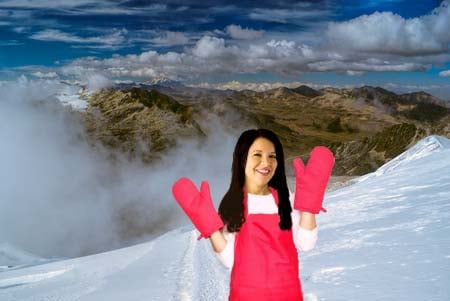I only live at 1,800 feet altitude; therefore, I don’t have any experience with high altitude baking. However, high-altitude baking creates similar problems to gluten free baking. Combine the two and you can turn into a gluten free recipe developer for high altitude baking in no time. It takes patience and experimentation to bake in high altitudes, whether the recipe is gluten free or not. After comparing standard high altitude baking tips with my knowledge of gluten free baking, I have compiled a few tips for you to use in high altitude gluten free baking. The decrease in air pressure can cause all sorts of problems, but baking gluten free can be easy once you get the hang of it. No matter what, each recipe needs unique adjustments for your altitude. I hope you find these tips useful.
Reduce Leavening Agents
High-altitudes create a large expansion of baked goods. Baking soda and baking powder amounts should be reduced. If you don’t, recipes tend to explode in the oven or expand beyond the pan and then fall. Begin by adjusting the recipe slowly. The next time you try the recipe, reduce the baking powder by 1/2 teaspoon and baking soda 1/8 teaspoon for every 3,000 feet of altitude, which may prevent this from happening.
Increase Baking Temperature
While increasing the baking temperature initially causes fast expansion, it prevents continued expansion by cooking the baked good quickly, setting it up faster. Decreasing the baking temperatures by 25ºF prevents fast expansion. Increasing the temperature also helps set the crust for yeast-based dough earlier, preventing over-expansion of the dough. Too high of a rise creates too many holes, which may collapse when the steam escapes, causing it to fall upon cooling.
You may have already seen many gluten free bread recipes with a temperature of 375ºF instead of 350ºF. Those baked at 350ºF are, instead, baked longer to prevent collapsing of high-risen baked items.
Decrease Baking Time
The science behind decreasing baking time in regular high-altitude baking is due to the increase in temperature and the pressure due to the increased altitude. However, with gluten free baking, items such as bread usually contain additional liquid and may need the same time to bake as directed by the recipe. You have to experiment as you bake to learn which recipes need to decrease the baking time. If you increase the baking temperature, this may be all you need to do. Meanwhile, if you do need to decrease the baking time, consider using the toothpick method earlier than recommended. When a toothpick inserted into the center of the item comes out clean, it is done, in most cases. However, the true indication of a cake being done is when it springs back when lightly pressed.
However, toothpick clean is not always the case with gluten free bread. When you have too much leavener that create lots of holes in the dough or batter, if you do not bake it past the clean toothpick stage, it may collapse. You need a balance of adjustments in this case.
Decrease Liquid
When you experience over-expanded baked goods, the rise and fall syndrome occurs. The item expands beyond the pan and falls when removed from the oven or sometimes sooner. When baked goods expand and then fall, consider reducing the liquid in the recipe. Decreasing liquid after falling may be applied to all gluten free baking.
Increase Liquid
High altitude may cause the liquid in your recipe to evaporate faster than usual. Flour also dries out and will absorb more liquid. If recipes turn out too dry, increase the liquid.
Rising Too High and Falling
Rising too high and then falling can always be corrected by creating more structure by increasing the amount of flour or gum, decreasing leavener, decreasing liquids, baking longer, or baking at a higher temperature. Sometimes, the answer is a combination of more than one solution.
Deep-Frying Adjustments
All gluten free goodies are not baked, but may be fried. Some are even deep-fried such as donuts or onion rings. In the case of deep-frying, decrease the temperature 3 degrees for each 1,000 feet of altitude.
Reduce Sugar
Because liquids tend to evaporate quickly, the ratio of sugar sometimes condenses. If your recipe turns out too sweet, consider reducing the sugar in a cake recipe by about 1 tablespoon for each 3,000 feet of altitude.
Gluten Free Bread Baking By Temperature
High elevation also effects the maximum temperature your bread dough will reach. This is based upon the highest boiling temperature of water allowed by your elevation. Use this Chart for Boiling Point. Just enter your elevation and click on “Calculate”. If you do not know the maximum temperature for your elevation and you’d like to bake your bread by temperature, you could easily over bake your dough.


